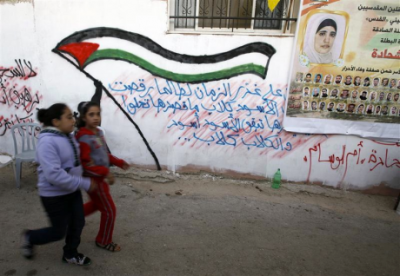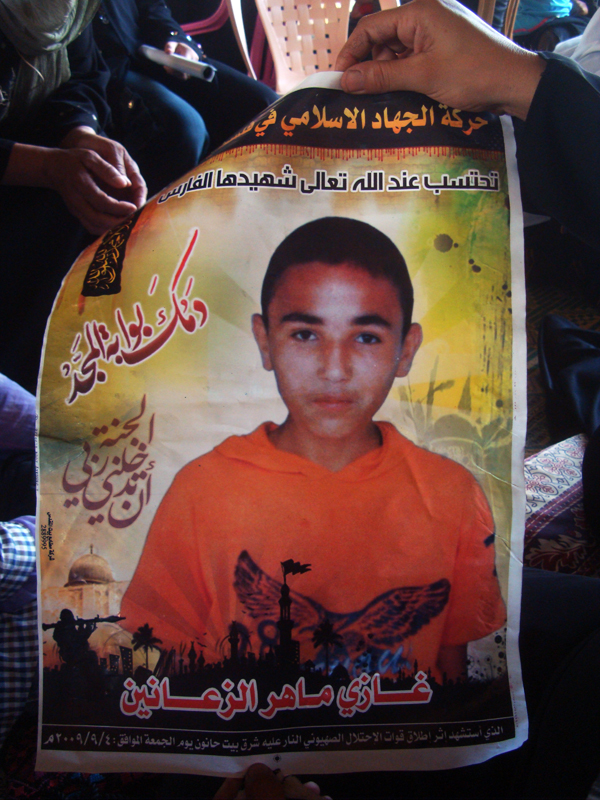13 December 2011 | AlertNet

Children walk past a poster welcoming freed Palestinian prisoners in Qalandiya refugee camp near the West Bank city of Ramallah, October 19, 2011. REUTERS/Eric Gaillard
The shootings reportedly took place between March 26 2010 and October 3, 2011, according to Defence for Children International (DCI)-Palestine Section . According to DCI, the Israeli soldiers often fire warning shots to scare off workers by the border. Their report also states that ‘these soldiers sometimes shoot and kill the donkeys used by the workers, and also target the workers, usually, but not always, shooting at their legs.’
‘That children are in a situation where they need to work to help their parents meet basic family needs is an infringement of their rights. That children are in the line of fire to meet these needs is appalling,’ says World Vision Programme Director for Gaza, Siobhan Kimmerle.
Forty percent of Gaza’s population is unemployed and 80% of the population is completely reliant on foreign assistance. In addition, Israeli restrictions limit the amount of construction material entering the Gaza borders for reconstruction and development. As a result, many workers collect gravel and sell it to builders to use for concrete. The children among the gravel collectors earn about US$8-$14 per day to help support their families.
The North Gaza governorate is one of the most impoverished governorates in the occupied Palestinian territories (oPt) and the neediest in the Gaza Strip. In comparison to the other governorates in the Gaza Strip, North Gaza’s food insecurity rate is the highest at 60% and the unemployment rate the second highest at 39%. World Vision works with communities in North Gaza to help improve family livelihoods and help ensure their children are cared for and protected.
Currently there are 2,411 registered children in World Vision’s North Gaza Area Development Programme, with 7,061 beneficiaries and as many as 22,594 indirect beneficiaries. World Vision’s programming in North Gaza includes rural development, job creation, and child empowerment projects.
The blockade of the Gaza Strip, including Israeli restrictions on items entering the borders, continue to harm Gaza’s deteriorating economy. The Israeli military continues to restrict Palestinians’ access to the land on the Gaza side of the Israeli-Gaza border, maintaining that anyone that comes within 300 metres of the borders puts his/her life at risk, which has had a negative impact on the physical security and livelihoods of Palestinians living in that area. DCI’s documentation indicates that children have been shot at while being between 30 to 800 metres within the Israeli border fence.
To read the DCI’s Urgent Appeal-Children of the Gravel, please visit http://www.dci-palestine.org/documents/urgent-appeal-ua-410-children-gravel.
World Vision continues to work for the well-being of children and advocate for an end to the Palestinian-Israeli conflict. World Vision believes that this conflict threatens the lives of all Palestinian and Israeli children, and one of the greatest obstacles to achieving fullness of life for each and every child is the ongoing conflict and the perpetuation of violence.
Sources:
1) Defence for Children International-Palestine Section, Urgent Appeal-Children of the Gravel, available at
http://www.dci-palestine.org/documents/urgent-appeal-ua-410-children-gravel-1
2) Central Intelligence Agency, The World Factbook, Gaza Strip, available at https://www.cia.gov/library/publications/the-world-factbook/geos/gz.html. Last accessed on November 25, 2011.
3) Oxfam International, Crisis in Gaza, available at http://www.oxfam.org/en/emergencies/gaza. Last accessed on December 9, 2011.



